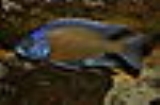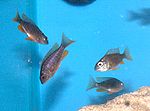
Copadichromis borleyi
Encyclopedia
Copadichromis borleyi is a species of cichlid
fish
endemic to Lake Malawi
in East Africa
. The species is popular in the fishkeeping
hobby where it is frequently kept in aquariums. The species has numerous common names used in the ornamental fish trade including: 'Redfin Hap' (or "Happy" or "Haplo") and 'Goldfin Hap'.
, males grow to 13-16 centimetres (5-6 in) total length, while females are typically slightly smaller reaching 13 centimetres. In addition to these minor difference in size, the species displays marked sexual dimorphism
with males displaying larger ventral fins marked with egg spots, light-blue edging to the dorsal
and ventral fins, along with metallic blue colouration of the head
, and yellow to red flanks. In contrast, females are silver-to-brown and display three black spots along their sides. Juveniles are monomorphic and are coloured like the adult females. Some intraspecific variation has been recorded with regard to colouration, these differently coloured forms are geographically restricted to certain localities in Lake Malawi.
, Mozambique
and Tanzania
. The species is limited to littoral zones with large rocks and boulders. The water in which species is found is warm (24 – 29 °C,75 – 84 °F), hard
and alkaline; typical of the water chemistry of Lake Malawi.
, by means of specialised, suction feeding action and highly protrudable mouth.
by David Eccles and Ethylwynn Trewavas
. The species is also known under the synonym Cyrtocara borleyi, and is occasionally sold under the trade name of Haplochromis granderus.
 C. borleyi is a polygamous, maternally mouthbrooding cichlid. Males frequently claim areas adjacent to, or on top of, large, submerged boulders and spawn on the horizontal upper surface of the boulder. Some geographic variants are known to build sand bowers atop large rocks in which spawning and courting takes place. The species has no defined breeding season and breeding occurs year round.
C. borleyi is a polygamous, maternally mouthbrooding cichlid. Males frequently claim areas adjacent to, or on top of, large, submerged boulders and spawn on the horizontal upper surface of the boulder. Some geographic variants are known to build sand bowers atop large rocks in which spawning and courting takes place. The species has no defined breeding season and breeding occurs year round.
Cichlid
Cichlids are fishes from the family Cichlidae in the order Perciformes. Cichlids are members of a group known as the Labroidei along with the wrasses , damselfish , and surfperches . This family is both large and diverse. At least 1,300 species have been scientifically described, making it one of...
fish
Fish
Fish are a paraphyletic group of organisms that consist of all gill-bearing aquatic vertebrate animals that lack limbs with digits. Included in this definition are the living hagfish, lampreys, and cartilaginous and bony fish, as well as various extinct related groups...
endemic to Lake Malawi
Lake Malawi
Lake Malawi , is an African Great Lake and the southernmost lake in the Great Rift Valley system of East Africa. This lake, the third largest in Africa and the eighth largest lake in the world, is located between Malawi, Mozambique, and Tanzania...
in East Africa
East Africa
East Africa or Eastern Africa is the easterly region of the African continent, variably defined by geography or geopolitics. In the UN scheme of geographic regions, 19 territories constitute Eastern Africa:...
. The species is popular in the fishkeeping
Fishkeeping
Fishkeeping is a popular hobby concerned with keeping fish in a home aquarium or garden pond. There is also a fishkeeping industry, as a branch of agriculture.-Types of fishkeeping systems:...
hobby where it is frequently kept in aquariums. The species has numerous common names used in the ornamental fish trade including: 'Redfin Hap' (or "Happy" or "Haplo") and 'Goldfin Hap'.
Appearance, size and sexual dimorphism
C. borleyi is a relatively small cichlidCichlid
Cichlids are fishes from the family Cichlidae in the order Perciformes. Cichlids are members of a group known as the Labroidei along with the wrasses , damselfish , and surfperches . This family is both large and diverse. At least 1,300 species have been scientifically described, making it one of...
, males grow to 13-16 centimetres (5-6 in) total length, while females are typically slightly smaller reaching 13 centimetres. In addition to these minor difference in size, the species displays marked sexual dimorphism
Sexual dimorphism
Sexual dimorphism is a phenotypic difference between males and females of the same species. Examples of such differences include differences in morphology, ornamentation, and behavior.-Examples:-Ornamentation / coloration:...
with males displaying larger ventral fins marked with egg spots, light-blue edging to the dorsal
Dorsal fin
A dorsal fin is a fin located on the backs of various unrelated marine and freshwater vertebrates, including most fishes, marine mammals , and the ichthyosaurs...
and ventral fins, along with metallic blue colouration of the head
Head
In anatomy, the head of an animal is the rostral part that usually comprises the brain, eyes, ears, nose and mouth . Some very simple animals may not have a head, but many bilaterally symmetric forms do....
, and yellow to red flanks. In contrast, females are silver-to-brown and display three black spots along their sides. Juveniles are monomorphic and are coloured like the adult females. Some intraspecific variation has been recorded with regard to colouration, these differently coloured forms are geographically restricted to certain localities in Lake Malawi.
Range and habitat
C. borleyi is widespread in Lake Malawi, occurring along the coasts of MalawiMalawi
The Republic of Malawi is a landlocked country in southeast Africa that was formerly known as Nyasaland. It is bordered by Zambia to the northwest, Tanzania to the northeast, and Mozambique on the east, south and west. The country is separated from Tanzania and Mozambique by Lake Malawi. Its size...
, Mozambique
Mozambique
Mozambique, officially the Republic of Mozambique , is a country in southeastern Africa bordered by the Indian Ocean to the east, Tanzania to the north, Malawi and Zambia to the northwest, Zimbabwe to the west and Swaziland and South Africa to the southwest...
and Tanzania
Tanzania
The United Republic of Tanzania is a country in East Africa bordered by Kenya and Uganda to the north, Rwanda, Burundi, and the Democratic Republic of the Congo to the west, and Zambia, Malawi, and Mozambique to the south. The country's eastern borders lie on the Indian Ocean.Tanzania is a state...
. The species is limited to littoral zones with large rocks and boulders. The water in which species is found is warm (24 – 29 °C,75 – 84 °F), hard
Hard water
Hard water is water that has high mineral content . Hard water has high concentrations of Ca2+ and Mg2+ ions. Hard water is generally not harmful to one's health but can pose serious problems in industrial settings, where water hardness is monitored to avoid costly breakdowns in boilers, cooling...
and alkaline; typical of the water chemistry of Lake Malawi.
Diet
The species feeds primarily on zooplanktonZooplankton
Zooplankton are heterotrophic plankton. Plankton are organisms drifting in oceans, seas, and bodies of fresh water. The word "zooplankton" is derived from the Greek zoon , meaning "animal", and , meaning "wanderer" or "drifter"...
, by means of specialised, suction feeding action and highly protrudable mouth.
Taxonomy
The species was described in 1960 by Thomas Derrick Iles as Haplochromis borleyi, and was later moved to CopadichromisCopadichromis
Copadichromis is a genus of haplochromine cichlids endemic to Lake Malawi in Eastern Africa. Many Copadichromis species are popular with aquarists who keep mbuna , as this genus is relatively peaceful in captivity.-Species:...
by David Eccles and Ethylwynn Trewavas
Ethylwynn Trewavas
Dr. Ethelwynn Trewavas was an ichthyologist at the British Museum of Natural History. She was known for her work on the families Cichlidae and Sciaenidae...
. The species is also known under the synonym Cyrtocara borleyi, and is occasionally sold under the trade name of Haplochromis granderus.
Reproduction

See also
- CichlidCichlidCichlids are fishes from the family Cichlidae in the order Perciformes. Cichlids are members of a group known as the Labroidei along with the wrasses , damselfish , and surfperches . This family is both large and diverse. At least 1,300 species have been scientifically described, making it one of...
- CopadichromisCopadichromisCopadichromis is a genus of haplochromine cichlids endemic to Lake Malawi in Eastern Africa. Many Copadichromis species are popular with aquarists who keep mbuna , as this genus is relatively peaceful in captivity.-Species:...
- HaplochromineHaplochromineThe haplochromine cichlids are a tribe of cichlids in subfamily Pseudocrenilabrinae called Haplochromini. This group includes the type genus plus a number of closely related genera such as Aulonocara, Astatotilapia, and Chilotilapia. They are endemic to eastern and southern Africa...
- List of freshwater aquarium fish species

